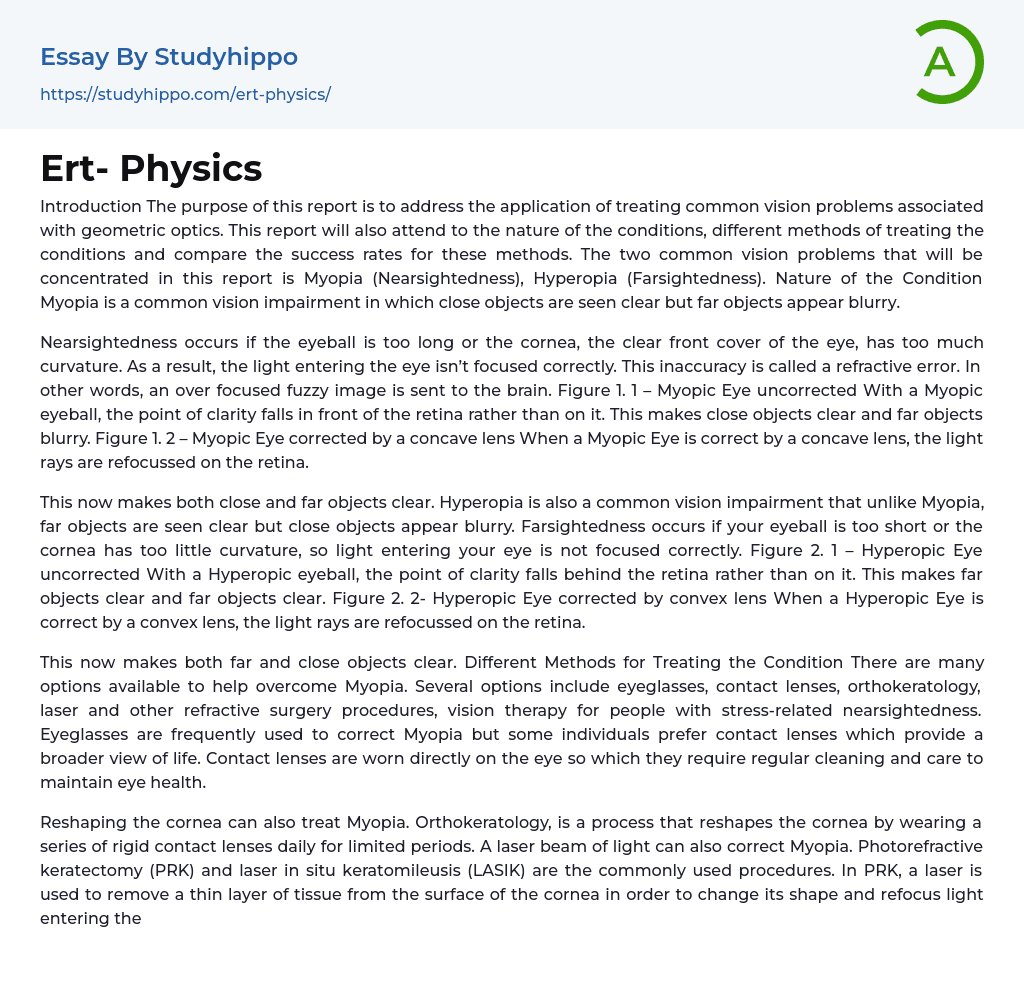The aim of this report is to examine and compare the treatment options for common vision problems related to geometric optics. It will assess the characteristics of these conditions, different methods of treatment, and their respective success rates. The focus will primarily be on two vision problems: Myopia (Nearsightedness) and Hyperopia (Farsightedness).
The condition referred to as myopia, also known as nearsightedness, occurs when the eyeball becomes elongated or the cornea develops excessive curvature. This causes a refractive error where light does not properly focus on the retina. In simpler terms, the brain receives an image that is blurry but overly focused. Figure 1.1 visually represents an uncorrected myopic eye where clarity is in front of the retina, resulting in distant objects appearing blurry while close objects remain clear. However, Figure 1.2 shows a co
...rrected myopic eye using a concave lens that accurately refocuses light rays onto the retina.
Hyperopia is a vision problem that affects many people. It causes close objects to appear blurry while distant objects remain clear. This condition occurs when the eyeball is too short or the cornea lacks curvature, leading to improper focus of light entering the eye. If left uncorrected, hyperopic eyes have a point of clarity behind the retina rather than on it, resulting in blurred vision for nearby objects but clear vision for those far away. Fortunately, using a convex lens can correct this issue by redirecting light rays onto the retina.
Now, both distant and nearby objects are easily visible with the help of this. There are different techniques available for treating Myopia. These options consist of eyeglasses, contact lenses, orthokeratology, laser surgery, and other
refractive procedures, as well as vision therapy for individuals experiencing nearsightedness due to stress. Eyeglasses are commonly used to correct Myopia; however, some individuals choose contact lenses as they provide a broader perspective on life. Contact lenses are placed directly on the eye and require regular cleaning and maintenance in order to maintain eye health.
There are different ways to treat myopia by reshaping the cornea. One method is Orthokeratology, where a series of rigid contact lenses are worn daily for specific periods. Laser procedures like Photorefractive keratectomy (PRK) and laser in situ keratomileusis (LASIK) are also options. PRK uses a laser to change the shape of the cornea by removing a thin layer of tissue from its surface, adjusting incoming light. However, there are limits on how much tissue can be safely removed, determining the level at which nearsightedness can be corrected.
LASIK surgery is a technique that involves cutting and folding back a section of the outer corneal surface to remove tissue from the inner layers of the cornea. The eye is then reshaped with a laser by precisely removing the necessary amount of tissue, after which the outer tissue flap is placed back in position for healing. The ability to correct vision using LASIK depends on how much corneal tissue can be safely removed. Hyperopia, also known as farsightedness, can be treated through different methods such as eyeglasses, contact lenses, and refractive surgeries like Laser-assisted subepithelial keratomileusis (LASEK) and Conductive Keratoplasty (CK). LASEK involves folding back a thin layer of the cornea to minimize damage and is suitable for individuals involved in sports or at risk of eye injuries. This procedure uses
radiofrequency energy to apply heat to specific areas on the cornea.
The radiofrequency's impact is similar to heating and stretching a plastic wrap. The curvature alteration of the cornea depends on spot spacing, quantity, and post-procedure healing. CK outcomes differ among individuals. Both Myopia and Hyperopia are effectively corrected by eyeglasses and contact lenses. However, the success rates of laser eye surgery are uncertain, with varying results. Treatment complications may arise.
A study published in the Archives of Ophthalmology found that LASIK and PRK surgeries have no long-term harmful effects on the cornea. The study observed 29 myopic patients who had undergone these surgeries, and after 9 years, no abnormal changes were detected. Although there was a slight decrease in endothelial cell density (5.3%), this is a normal decline that even occurs in individuals without refractive procedures. Far-sighted patients were not included in the study; however, researchers believe that the findings would likely be comparable for them too.
- Incandescent Light Bulb essays
- Action Potential essays
- Blood essays
- Body essays
- Brain essays
- Childbirth essays
- Eye essays
- Glucose essays
- Heart essays
- Human Physiology essays
- Immune System essays
- Kidney essays
- Muscle essays
- Nervous System essays
- Neuron essays
- Poison essays
- Puberty essays
- Sense essays
- Skeleton essays
- Skin essays
- Atom essays
- Big Bang Theory essays
- Density essays
- Electricity essays
- Energy essays
- Force essays
- Heat essays
- Light essays
- Motion essays
- Nuclear Power essays
- Physiology essays
- Sound essays
- Speed essays
- Temperature essays
- Thermodynamics essays
- John Locke essays
- 9/11 essays
- A Good Teacher essays
- A Healthy Diet essays
- A Modest Proposal essays
- A&P essays
- Academic Achievement essays
- Achievement essays
- Achieving goals essays
- Admission essays
- Advantages And Disadvantages Of Internet essays
- Alcoholic drinks essays
- Ammonia essays
- Analytical essays
- Ancient Olympic Games essays




